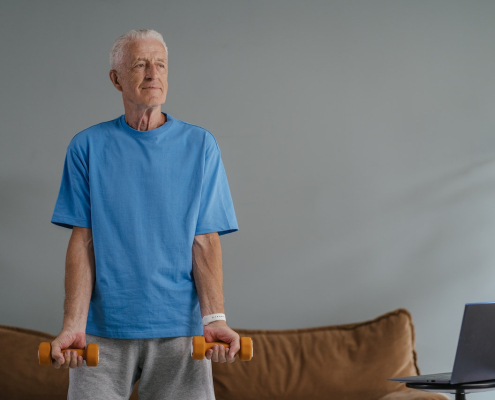
Parkinson’s Disease
Parkinson’s Disease (PD) is a progressive neurodegenerative disorder that primarily affects movement and motor function. The condition results from the gradual degeneration of dopamine-producing neurons in a region of the brain called the substantia nigra. Dopamine is a neurotransmitter responsible for coordinating movement, and its depletion leads to the characteristic symptoms of PD. Although the exact cause of PD is unknown, a combination of genetic, environmental, and age-related factors is believed to contribute to its development. This comprehensive overview of Parkinson’s Disease will cover its symptoms, stages, risk factors, diagnosis, treatment, and current research directions, providing a thorough understanding of this complex condition.
Symptoms & Stages
Parkinson’s Disease symptoms can be categorised into motor and non-motor symptoms. The primary motor symptoms of PD include:
- Tremor:
Involuntary shaking or trembling, often beginning in one hand or arm, is the most recognisable symptom of PD. Tremors usually occur at rest and may worsen with stress or fatigue. - Bradykinesia:
This term refers to slowness of movement and can manifest as a reduced ability to initiate or maintain movement, resulting in difficulty with everyday tasks. - Rigidity:
Muscle stiffness and increased resistance to passive movement can lead to pain and limited range of motion. - Postural instability:
Balance problems and a tendency to fall become more common as PD progresses.
In addition to these motor symptoms, PD is also associated with numerous non-motor symptoms, which may include:
- Cognitive impairment:
Problems with memory, attention, and problem-solving can occur, with dementia affecting up to 80% of individuals with PD in advanced stages. - Mood disorders:
Depression and anxiety are common in people with PD and can significantly impact quality of life. - Sleep disturbances:
Insomnia, excessive daytime sleepiness, and rapid eye movement (REM) sleep behavior disorder are frequently reported in PD patients. - Autonomic dysfunction:
This can manifest as orthostatic hypotension (a sudden drop in blood pressure upon standing), urinary incontinence, constipation, and sexual dysfunction. - Sensory changes:
Loss of smell (anosmia) is often an early symptom, while pain and altered sensation may develop later in the disease course.
PD is typically divided into five stages, based on the severity and progression of symptoms:
- Stage 1: Mild symptoms, usually affecting only one side of the body.
- Stage 2: Symptoms worsen, affecting both sides of the body, but balance remains intact.
- Stage 3: Mid-stage, characterised by worsening of motor symptoms and the onset of postural instability.
- Stage 4: Advanced stage, marked by significant disability and a need for assistance with daily activities.
- Stage 5: Severe stage, characterised by immobility, dependence on a wheelchair or bed-bound, and a need for full-time care.
Risk Factors
Several factors have been identified that may increase the risk of developing Parkinson’s Disease:
- Age:
PD is primarily a disease of older adults, with the average age of onset around 60 years. The risk of developing PD increases with age. - Gender:
Men are 1.5 times more likely to develop PD than women, although the reasons for this disparity are not yet understood. - Family history:
Individuals with a close relative with PD have an increased risk of developing the disease, although most cases are sporadic and not inherited. - Genetic factors:
Specific gene mutations have been identified that can increase the risk of PD, but these account for a small percentage of cases. - Environmental factors:
Exposure to certain toxins, such as pesticides and herbicides, may be associated with an increased risk of PD.

Diagnosis
There is no definitive test for Parkinson’s Disease, and diagnosis is primarily based on clinical observation, medical history, and the presence of characteristic motor symptoms. A thorough neurological examination will be performed to assess motor function, muscle tone, reflexes, and coordination. The diagnosis of PD can be challenging, especially in the early stages, as its symptoms overlap with those of other movement disorders.
Diagnostic tests, such as magnetic resonance imaging (MRI) and computed tomography (CT) scans, may be used to rule out other neurological conditions. In some cases, a dopamine transporter (DaT) scan, which uses a radiolabeled tracer to visualise dopamine transporter levels in the brain, can help support the diagnosis of PD.
Treatment
While there is currently no cure for Parkinson’s Disease, various treatments are available to help manage symptoms and improve quality of life. Treatment options include:
Medications
Several medications can help alleviate motor symptoms by increasing dopamine levels in the brain or mimicking its effects. The most commonly prescribed medication for PD is levodopa, often combined with carbidopa to reduce side effects. Other medications include dopamine agonists, monoamine oxidase-B (MAO-B) inhibitors, catechol-O-methyltransferase (COMT) inhibitors, and anticholinergic drugs.
Deep Brain Stimulation (DBS)
This surgical procedure involves implanting electrodes in specific regions of the brain and connecting them to a device called a neurostimulator, which sends electrical impulses to modulate brain activity. DBS is typically reserved for patients with advanced PD who no longer respond well to medications.
Physiotherapy
Regular physiotherapy can help maintain mobility, strength, and balance, improving overall functioning and reducing the risk of falls.
Occupational therapy
Occupational therapists can provide strategies and adaptive equipment to help individuals with PD manage daily activities more effectively.
Speech therapy
Speech and language therapists can address speech and swallowing difficulties associated with PD, helping to improve communication and reduce the risk of aspiration.
Complementary therapies
Some individuals with PD may benefit from complementary therapies such as massage, acupuncture, tai chi, and yoga, which can help alleviate pain, stiffness, and stress.
Supportive care
Psychological counseling, support groups, and social services can help individuals with PD and their families cope with the emotional and practical challenges of living with a chronic, progressive illness.
Current Research Directions
Ongoing research is essential for understanding the underlying mechanisms of Parkinson’s Disease and developing more effective treatments. Some areas of active research include:
- Understanding the role of alpha-synuclein: The abnormal accumulation of alpha-synuclein protein in the brain is a hallmark of PD. Research is focused on understanding the mechanisms underlying this aggregation and its role in neurodegeneration.
- Identifying biomarkers: The discovery of reliable biomarkers for PD could facilitate early diagnosis, track disease progression, and help identify individuals who may benefit from specific treatments.
- Investigating the role of genetics: Studying the genes associated with PD can provide insights into the mechanisms of the disease and potentially identify new therapeutic targets.
- Developing neuroprotective therapies: Researchers are exploring strategies to protect and repair dopamine-producing neurons, potentially slowing or halting the progression of PD.
- Exploring stem cell therapy: The use of stem cells to replace lost dopamine-producing neurons is a promising area of research, with the potential to significantly improve motor symptoms in PD patients.
- Investigating the role of the gut-brain axis: Research suggests that the gut microbiome may play a role in PD, with potential implications for early diagnosis and treatment.
- Examining the effects of lifestyle factors: Studies are ongoing to determine the impact of diet, exercise, and other lifestyle factors on PD risk and progression, with the aim of developing evidence-based prevention and management strategies.
- Improving deep brain stimulation (DBS): Researchers are working on refining DBS techniques, identifying optimal stimulation parameters, and exploring the potential benefits of adaptive or closed-loop stimulation systems.
- Evaluating novel drug delivery methods: Alternative methods of delivering PD medications, such as continuous infusion pumps, transdermal patches, and inhaled formulations, are being investigated to optimise drug delivery and reduce side effects.
- Investigating non-pharmacological interventions: Research into the benefits of various non-pharmacological interventions, such as cognitive-behavioral therapy, mindfulness, and virtual reality-based rehabilitation, aims to improve quality of life and overall well-being in individuals with PD.
Conclusion
Parkinson’s Disease is a complex neurodegenerative disorder characterised by a progressive decline in motor function and a range of non-motor symptoms. While the exact cause of PD remains unknown, a combination of genetic, environmental, and age-related factors is believed to contribute to its development. Advances in our understanding of PD have led to the development of various treatments that can help manage symptoms and improve quality of life. However, there is still much to learn about the underlying mechanisms of the disease, and ongoing research is crucial for the development of more effective treatments, early diagnosis methods, and, eventually, a cure.
